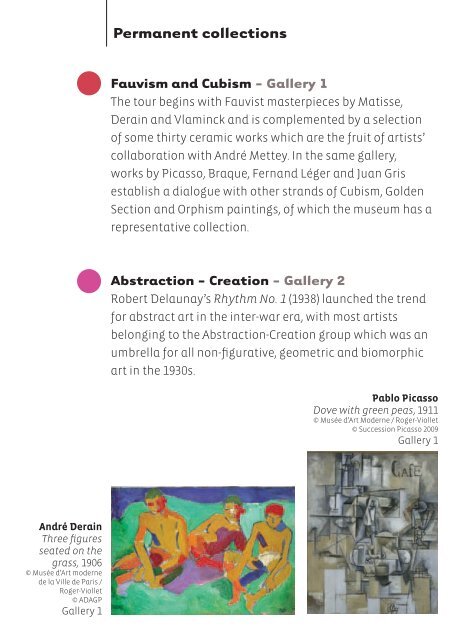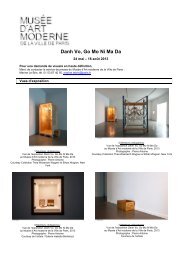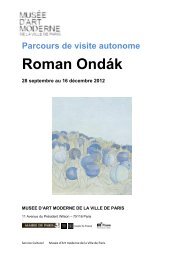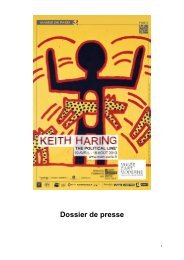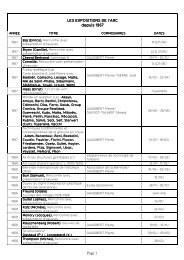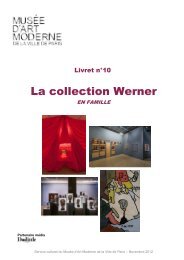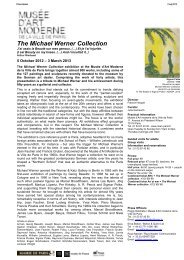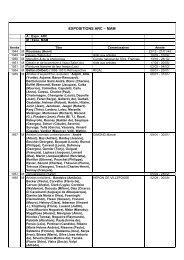A guide to the collection - Musée d'Art Moderne - Ville de Paris
A guide to the collection - Musée d'Art Moderne - Ville de Paris
A guide to the collection - Musée d'Art Moderne - Ville de Paris
You also want an ePaper? Increase the reach of your titles
YUMPU automatically turns print PDFs into web optimized ePapers that Google loves.
André Derain<br />
Three figures<br />
seated on <strong>the</strong><br />
grass, 1906<br />
© <strong>Musée</strong> d’Art mo<strong>de</strong>rne<br />
<strong>de</strong> la <strong>Ville</strong> <strong>de</strong> <strong>Paris</strong> /<br />
Roger-Viollet<br />
© ADAGP<br />
Gallery 1<br />
Permanent <strong>collection</strong>s Permanent <strong>collection</strong>s<br />
Fauvism and Cubism - Gallery 1<br />
The <strong>to</strong>ur begins with Fauvist masterpieces by Matisse,<br />
Derain and Vlaminck and is complemented by a selection<br />
of some thirty ceramic works which are <strong>the</strong> fruit of artists’<br />
collaboration with André Mettey. In <strong>the</strong> same gallery,<br />
works by Picasso, Braque, Fernand Léger and Juan Gris<br />
establish a dialogue with o<strong>the</strong>r strands of Cubism, Gol<strong>de</strong>n<br />
Section and Orphism paintings, of which <strong>the</strong> museum has a<br />
representative <strong>collection</strong>.<br />
Abstraction - Creation - Gallery 2<br />
Robert Delaunay’s Rhythm No. 1 (1938) launched <strong>the</strong> trend<br />
for abstract art in <strong>the</strong> inter-war era, with most artists<br />
belonging <strong>to</strong> <strong>the</strong> Abstraction-Creation group which was an<br />
umbrella for all non-figurative, geometric and biomorphic<br />
art in <strong>the</strong> 1930s.<br />
Pablo Picasso<br />
Dove with green peas, 1911<br />
© <strong>Musée</strong> d’Art <strong>Mo<strong>de</strong>rne</strong> / Roger-Viollet<br />
© Succession Picasso 2009<br />
Gallery 1<br />
Decorative Arts Gallery<br />
Jean Dunand,<br />
Sports, 1935<br />
André Arbus, Suite<br />
of furniture for <strong>the</strong><br />
Society of Interior<br />
Decora<strong>to</strong>rs’ pavilion<br />
at <strong>the</strong> International<br />
Exhibition, 1937<br />
© Pierre An<strong>to</strong>ine<br />
Decorative Arts - Gallery 3<br />
One of <strong>the</strong> monumental galleries overlooking <strong>the</strong> Seine<br />
displays a <strong>collection</strong> of <strong>de</strong>corative art from <strong>the</strong> 1930s<br />
consisting of furniture and objets d’art. Around a painted<br />
panel entitled Sports (1935), created by Dunand for <strong>the</strong><br />
steamship Normandie, is prestigious furniture <strong>de</strong>signed<br />
by Ruhlmann, Printz, Arbus, Chareau and Adnet testifying<br />
<strong>to</strong> <strong>the</strong> City of <strong>Paris</strong>’ commitment <strong>to</strong> classic and mo<strong>de</strong>rnist<br />
<strong>de</strong>corative arts when <strong>the</strong> museum was established.<br />
During <strong>the</strong> 1937 International Arts and Technology<br />
Exhibition, <strong>the</strong> City of <strong>Paris</strong> purchased many high-quality,<br />
lavishly-worked objects from leading ceramicists,<br />
glassworkers, brass workers and metalworkers, which<br />
pushed <strong>the</strong> existing boundaries of form and materials.


